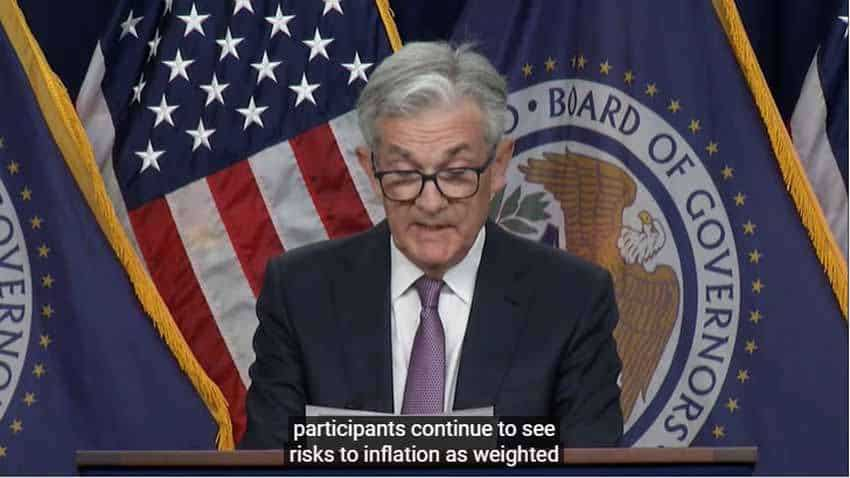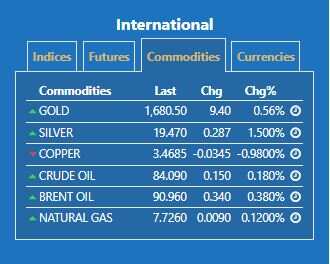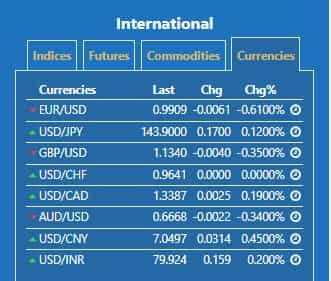FOMC Meeting September 2022 Live Updates: Fed raises rates by 75 bps to 3% to 3.25% range; Watch Chair Jerome Powell's press conference

FOMC Meeting September 2022 Live Updates: The Federal Reserve raised its target interest rate by three-quarters of a percentage point to a range of 3.00%-3.25% on Wednesday and signaled more large increases to come in new projections showing its policy rate rising to 4.40% by the end of this year before topping out at 4.60% in 2023 to battle continued strong inflation.
The two-day Feederal Open Market Committee (FOMC) meeting of the US Federal Reserve began on Tuesday, 20 September 2022. The committee, which was headed by Chair Jerome Powell anounced a 75 bps interest rate hike on Wednesday as was expected. In the previous monetary policy announcement, the Central Bank had raised the rates by 75 bps while maintaining that it was committed to contain inflation at 2 per cent. The Chair had said that price stability was the bedrock of economy.
The Monetary Policy announcements are likley to be done around 12 am India time.
The US CPI inflation stood at 8.3 per cent in August, over four times the Fed's target level.
The Monetary Policy announcements will be done by Fed Chair Jerome Powell. The press conference will be live at 2:30 pm ET or 12 am Indian Standard Time. The press conference could be view directly on the official website federalreserve.gov or on the official Twitter handle @federalreserve.
The Central Bank has also tweeted regarding this:
Tomorrow at 2:30 p.m. ET: Chair Powell hosts live #FOMC press conference: https://t.co/1uJrua5Yif pic.twitter.com/752ORoGYWl
— Federal Reserve (@federalreserve) September 20, 2022
The FOMC minutes of the meeting will be released on 12 October.
FOMC Meeting September 2022 Live Updates: The Federal Reserve raised its target interest rate by three-quarters of a percentage point to a range of 3.00%-3.25% on Wednesday and signaled more large increases to come in new projections showing its policy rate rising to 4.40% by the end of this year before topping out at 4.60% in 2023 to battle continued strong inflation.
The two-day Feederal Open Market Committee (FOMC) meeting of the US Federal Reserve began on Tuesday, 20 September 2022. The committee, which was headed by Chair Jerome Powell anounced a 75 bps interest rate hike on Wednesday as was expected. In the previous monetary policy announcement, the Central Bank had raised the rates by 75 bps while maintaining that it was committed to contain inflation at 2 per cent. The Chair had said that price stability was the bedrock of economy.
The Monetary Policy announcements are likley to be done around 12 am India time.
The US CPI inflation stood at 8.3 per cent in August, over four times the Fed's target level.
The Monetary Policy announcements will be done by Fed Chair Jerome Powell. The press conference will be live at 2:30 pm ET or 12 am Indian Standard Time. The press conference could be view directly on the official website federalreserve.gov or on the official Twitter handle @federalreserve.
The Central Bank has also tweeted regarding this:
Tomorrow at 2:30 p.m. ET: Chair Powell hosts live #FOMC press conference: https://t.co/1uJrua5Yif pic.twitter.com/752ORoGYWl
— Federal Reserve (@federalreserve) September 20, 2022
The FOMC minutes of the meeting will be released on 12 October.
Latest Updates
Economic Projections - https://www.federalreserve.gov/monetarypolicy/files/fomcprojtabl20220921...
US Fed Chair Jerome Powell: Stance of FOMC unchanged from Jackson Hole Meeting and Fed committed to bring down inflation to 2 per cent.
US Fed Chair Jerome Powell: We want to see growth moving below the trends.
US Fed Chair Jerome Powell: Reducing rates only if Fed is confident of achieving the 2 per cent target.
Fed Chair Jerome Powell: Committed to bring inflation at 2%
Fed Chair Jerome Powell: Price stability a priority
Fed Chair Jerome Powell: FOMC raised rates by three quarter of a percent
Fed Chair Jerome Powell: US economy has slowed from peak of 2021
Fed Chair Jerome Powell: Consumtion has slowed
Fed Chair Jerome Powell: Lbour market extremely tight with unemployment at 50 year low
Fed Chair Jerome Powell: Labour force participation has seen an up tick
The Federal Reserve raised its target interest rate by three-quarters of a percentage point to a range of 3.00%-3.25% on Wednesday and signaled more large increases to come in new projections showing its policy rate rising to 4.40% by the end of this year before topping out at 4.60% in 2023 to battle continued strong inflation, Reuters reported.
Less than three hours left for the crucial US Federal Monetary Policy announcement. You can catch the press conference of US Federal Reserve Chair Jerome Powell Live at this link youtube.com/federalreserve:
"WATCH LIVE TODAY: Press conference with #FOMC Chair Powell at 2:30 p.m. ET: https://federalreserve.gov https://youtube.com/federalreserve," the Central Bank tweeted from its official twitter handle.
WATCH LIVE TODAY: Press conference with #FOMC Chair Powell at 2:30 p.m. ET: https://t.co/1uJrua5Yifhttps://t.co/FJa6TblbC1 pic.twitter.com/Ckmdn8ORY7
— Federal Reserve (@federalreserve) September 21, 2022
US markets today shed their Tuesday blues and were trading in the green on Wednesday hours before the Federal Open Market Committee (FOMC) monetray policy announcements. The US Federal Reserve is expected to increase interest rate by at least 75 bps. The 2-day meeting ends today.
- Dow 30 was trading at 30,886.20, up by 179.98 points or 0.59 per cent.
- S&P 500 was trading at 3,877.66, down by 21.73 points or 0.56 per cent.
- NASDAQ COMPOSITE was trading at 11,462.90, up by 37.88 or 0.33 per cent.
The announcement will come around 2:30 pm ET or 12 am IST.
e
Darshan Engineer, Fund Manager, Karma Capital
"Inflation is currently higher than fed's comfort majorly due to supply chain disruption and geo political tensions. It won't be easy for fed to bring it down without hiking rates to higher than current levels.
This will lead to sharp slow down and US being largest consumer and largest economy will effect the rest of the world.
India being a large exporter of IT services, Pharma and Industrial Goods to US is bound to get affected, further causing pain in dependent sectors like commercial real estate, Auto etc."
Roopali Prabhu, CIO and Co-Head Products & Solutions, Sanctum Wealth
Fund managers might tweak portfolios when the overall interest rate environment changes, but typically don’t tend to respond to a particular event of rate hike. Having said that, if the undertone to Fed speak is hawkish, sentiments could dampen temporarily and sectors such cement, auto that have rallied recently could see some correction even though these are more domestic economy oriented. The IT sector has borne the majority of the FII selling of the first half of the calendar and therefore may fall in line with the markets. Consequently, funds that are overweight in these sectors might be more impacted than the others. However, investors have to be mindful that in the past few days, broader markets have corrected more than is reflected in the index movement.
Gold Price Today 21 September 2022: The Monetary Policy Announcements by the US Federal Reserve is just a few hours away. The Fed is expected to increase interest rates by 75 bps. The announcements will likley have an impact on commodity and equity markets.
MCX October Gold futures were trading with a positive bias on Wednesday at Rs 49487 per 10 gram and were higher by Rs 312 or 0.63 per cent from the Tuesday closing price. Meanwhile the December Silver Futures were also trading positively at Rs 57205 per kg and were up by Rs 862 0r 1.5 per cent at 4:45 pm.
Indian stock markets ended Thursday in the red. While the Nifty50 fell by nearly 100 points or 0.55 per cent to 17718.35, the BSE Sensex closed at 59,456.78,down by 262.96 pointsor 0.44 per cent. Nifty Bank ene at 41203.45, lower by 264 points or 0.64 per cent from the the Tuesay closing. Nifty FMCG was the lone gainer among the 15 sectoral indices with Nifty Metal and Nifty Oil & Gas getting a severe drubbing.
Also Read:Stock Market Today 21 Sept 2022: Top Gainers and Losers - What investors should know
Dollar Index (DXY) gained strength leading to weakness in other currencies. USDINR September futures were trading at 80.0150 on the BSE, up 0.2450 paise or 0.31 per cent.
Rupee Vs Dollar: interbank foreign exchange market
The rupee declined by 26 paise to close at 80.00 (provisional) against the US dollar on Wednesday, tracking the strength of the American currency in the overseas market and a muted trend in domestic equities.
Forex traders said investors are awaiting the US Fed's policy decision on interest rates for further cues. Moreover, risk-off mood and firm crude oil prices weighed on the local unit.
At the interbank foreign exchange market, the domestic currency opened at 79.81 per dollar. It hovered in a range of 79.79 to 80.00 during the session.
The rupee finally settled at 80.00, down 26 paise over its previous close.
Inputs from PTI
Global recession and India:
Global rating agency S&P on Tuesday said even though the US and the Euro zone are headed to recession, India is unlikely to face the impact given the "not so coupled" nature of its economy with the global economy.
"Indian economy is a lot decoupled from the global economy than we normally think of, given its large domestic demand, even though you (India) are a net importer of energy. But you have enough forex reserves on one hand and your companies have managed to maintain healthy balance sheets," Paul F Gruenwald, S&P global chief economist and managing director, told reporters here.
In fact, India was never coupled fully with the global economy and so is relatively independent of global markets, he said, adding that a lot depends on how global fund flows behave if there is a recession in the US and Europe. Their inflation numbers continue to dodge the monetary actions by their central banks as the gap between the US core inflation target and the actual number is three times at 6 per cent.
Listing out inflation and the resultant measures by the US Fed as the main threat to the US economy, he said, the world's largest economy is headed towards recession, which is the result of an overheated economy because even after inflation hitting a four-decade high, unemployment rate is so low at 3.7 per cent.
"Our house view is of a 50-50 chance of recession in the US as the output gap is still positive but the consumer and business sentiment is negative. Whether this will be a soft-landing or not, it will be known either later this year or early next year as the impact of the massive rate hikes by the US Fed will be known only by then," Gruenwald added.
On the Euro zone, the managing director said the problem is more entrenched and structural. It will take time to recover as the crisis is the result of the geopolitical issues (Russia-Ukraine war) the sky-high energy prices after the EU nations began to lower their dependence on gas from the Russia since February. But again the EU joblessness rates are low at 6.5 per cent.
The continent will face the crisis if joblessness becomes more pronounced, Gruenwald said, adding, the house view is less than a 50 per cent chance for a recession in the Euro zone which is saddled by the Russia-Ukraine war and by the resultant energy security issues. It will take a couple of years to recover if it falls into a recession unlike the US which may recover much faster.
The US and European recession depends on the central banks ignoring slowing growth and opting to fight inflation instead.
Describing the Chinese slowdown as the worst in decades, he highlighted that this is a self-inflicted pain arising out of its zero tolerance policy towards Covid.
According to him, China has never missed its growth targets as badly as this year (down from over 5 per cent to under 3 per cent or even less). The communist party congress in November may throw in some positive surprises, in which case the negative forecast may reverse.
To a question given all these global headwinds whether the agency has a new view on Indian growth numbers, Crisil Ratings (which is majority-owned by S&P Global Ratings) chief economist D K Joshi told PTI that they hold their recent forecast wherein they "expect the economy to grow at 7.3 per cent this fiscal and slow down to 6.5 per cent next fiscal, with more downside risks to both the numbers."
Joining Joshi, Gruenwald said, despite these headwinds, India will be doing a lot better than the rest of the world.
Motilal Oswal Report : "Crude Oil prices tumbled amid a risk-off tone across markets weighed on crude oil sentiment. Prices fell a day before a Federal Reserve rate decision that’s likely to deliver a third straight substantial rate hike for United States. Central banks are poised to raise rates this week in an effort to tame inflation. This has led to thin liquidity and wild price moves as traders are reluctant to lock into a strong position. Also weighing on oil was U.S. Transportation Department data showing domestic vehicle travel in July fell 3.3% to 286.6 billion miles, the second consecutive monthly decline in American driving in the face of high fuel prices. The US announced that it will offer an additional 10mbbl from its strategic reserve. On API data front, U.S. crude inventories rose by 1.0 million barrels. That compared with expecting an increase of about 2.3 MBs. On the sideline of the UN General Assembly, Iran’s Foreign Ministry spokesperson said discussions on efforts to resurrect the nuclear deal are possible. Still, Saudi Aramco warned that the world’s spare oil production capacity will be quickly used up when global economy recovers. Russia’s oil exports are falling. Crude shipments in the first two weeks of September dropped by almost 900kb/d to 2.54mb/d. This compares with 3.42mb/d in the seven days to 2 September.".
FOMC Meeting September 2022: Expectations:
It is unlikley that Chair Powell will drop hints of easing up its credit tightening in the wake of the current challenges around the inflation.
The central bank has already engaged in the fastest series of rate hikes since the early 1980s. Yet some economists and some Fed officials argue that they have yet to raise rates to a level that would actually restrict borrowing and spending and slow growth.
While most economists expect the Fed to stop raising rates in early 2023. But for now, they expect Powell to reinforce his hard-line anti-inflation stance.
It's going to end up being a hard landing, said Kathy Bostjancic, an economist at Oxford Economics. He's not going to say that," Bostjancic said.
But, referring to the most recent Fed meeting in July, when Powell raised hopes for an eventual pullback on rate hikes, she added: "He also wants to make sure that the markets don't come away and rally. That's what happened last time.
Indeed, investors responded then by bidding up stock prices and buying bonds, which lowered rates on securities like the benchmark the 10-year Treasury.
Higher stock prices and lower bond yields generally boost the economy the opposite of what the Fed wants.
Loretta Mester, president of the Cleveland Federal Reserve Bank, and one of the 12 officials who will vote on the Fed's decision on Wednesday, said she thinks it will be necessary to raise the Fed's rate to somewhat above 4 per cent by early next year and hold it there".
I do not anticipate the Fed cutting rates next year, Mester added, dispelling the expectations of many investors on Wall Street who had hoped for such a reversal.
Comments like Mester's contributed to a sharp fall in stock prices last month that began after Powell's stern anti-inflation speech at the conference in Jackson Hole.
Our responsibility to deliver price stability is unconditional, Powell had then said then - a remark widely interpreted to mean that the Fed will fight inflation even if it requires deep job losses and a recession.
Many economists sound convinced that a recession and widespread layoffs will be necessary to slow rising prices.
Research published earlier this month under the auspices of the Brookings Institution concluded that unemployment might have to go as high as 7.5 per cent to get inflation back to the Fed's 2 per cent target.
Only a downturn that harsh would reduce wage growth and consumer spending enough to cool inflation, according to the a paper by Johns Hopkins University economist Laurence Ball and two economists at the International Monetary Fund.
Inputs from PTI







 Source: Comexlive.org
Source: Comexlive.org